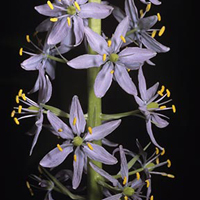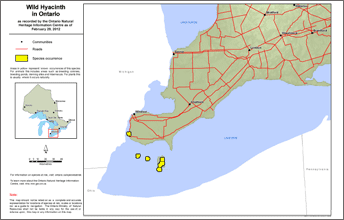Wild hyacinth
Scientific name: Camassia scilloides

Cover photo credit: Allen Woodliffe
Status
Threatened
“Threatened” means the species lives in the wild in Ontario, is not endangered, but is likely to become endangered if steps are not taken to address factors threatening it.
Date added to the Species at Risk in Ontario List
The Wild hyacinth was already assessed as threatened when the Endangered Species Act took effect in 2008.
What it looks like
Wild hyacinth is a tall perennial plant in the lily family, growing to 70 centimetres in height. It produces spectacular pale blue or white six parted star-shaped flowers with conspicuous yellow anthers.
The flowers grow in loose spike-like clusters. Several linear leaves emerge from the base of the plant. Ripe seedpods of this plant split open to release many small seeds.
Where it lives
Wild hyacinth grows best in light to moderate shade. In Ontario, Wild hyacinth prefers openings in woodlands, shrubby areas and forest edges. This species requires rich soil.
Where it’s been found in Ontario
In Canada, Wild hyacinth is found only in southwest Ontario. Based on surveys in 1998 and 2001 it is believed to exist at only six sites scattered over a few islands in west Lake Erie, including Pelee Island, with most of these populations consisting of 2,000 to 5,000 plants.
View a larger version of this map (PDF)
What threatens it
The greatest threats to Wild hyacinth are habitat destruction from recreational development, and illegal collection.
Populations of the colonial nesting double crested cormorants threaten Wild hyacinth on Middle Island because the droppings of these birds are toxic to the plants. Invasive plants, such as Garlic mustard and Norway maple, are also a problem.
Action we are taking
Threatened Species and their general habitat are automatically protected.
Recovery strategy
A recovery strategy advises the ministry on ways to ensure healthy numbers of the species return to Ontario.
Read the executive summary (January 11, 2013)
Read the recovery strategy (January 11, 2013)
Government response statement
A government response statement outlines the actions the government intends to take or support to help recover the species.
Read the government response statement (October 11, 2013)
Five-year review of progress
A five-year review of progress made toward protecting and recovering a species is required no later than five years after the government response statement for that species is published.
Read the report on progress towards the protection and recovery of 17 species at risk, including the Wild Hyacinth (2018).
Habitat protection
General Habitat Protection - June 30, 2013
What you can do
Report a sighting
Report a sighting of an endangered animal or plant to the Natural Heritage Information Centre. Photographs with specific locations or mapping coordinates are always helpful.
Volunteer
Volunteer with your local nature club or provincial park to participate in surveys or stewardship work focused on species at risk.
Be a good steward
- private land owners have a very important role to play in species recovery; if you find Wild hyacinth on your land, you may be eligible for stewardship programs that support the protection and recovery of species at risk and their habitats
- invasive species seriously threaten many of Ontario’s species at risk; to learn what you can do to help reduce the threat of invasive species, visit:
- pollinators, such as bees, are in steep decline across the globe and they play a key role in the survival of many of Ontario’s rare plants; for information on how you can help scientists monitor pollinator populations in Ontario visit:
www.seeds.ca/proj/poll - Purple twayblade and many other species at risk depend on healthy grassland prairies, a rare habitat in Ontario; learn more about these habitats, the species that depend on them, and what you can do to help at:
www.tallgrassontario.org - the Carolinian forests of southern Ontario support an amazing diversity of plants and wildlife, including many species at risk; Carolinian Canada is working to help recover species at risk and their habitats; for more information, visit:
www.carolinian.org/SpeciesHabitats.htm
Report illegal activity
Report any illegal activity related to plants and wildlife to
Quick facts
- Wild hyacinth flowers are pollinated by butterflies, bumblebees, and flies; many populations of these insect-pollinators are declining around the world; you can help Ontario’s pollinators by planting insect-friendly plants such as milkweed, daisies and goldenrods
- Aboriginal people and early European settlers used the Wild hyacinth as a food source, eating the boiled, baked, or raw underground bulbs of this plant
- Wild hyacinth is grown in gardens around the world for its beautiful flowers
- a single Wild hyacinth can produce over 100 flowers in a single season
